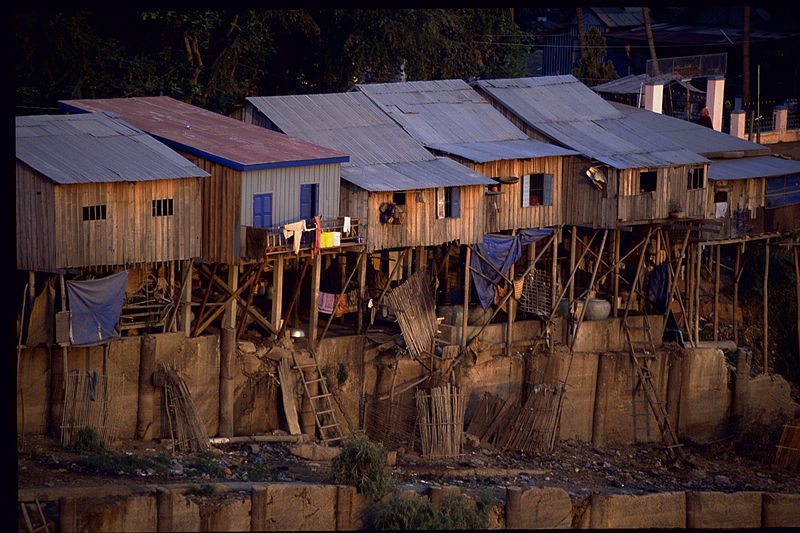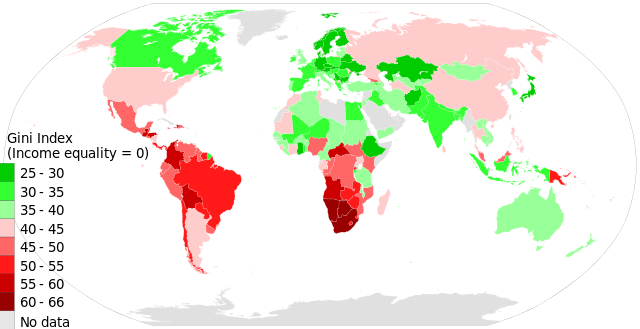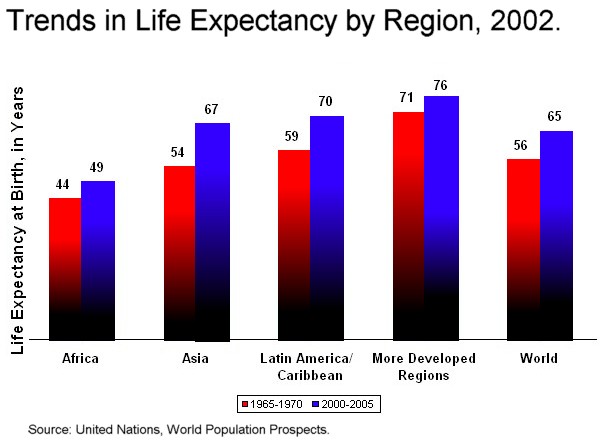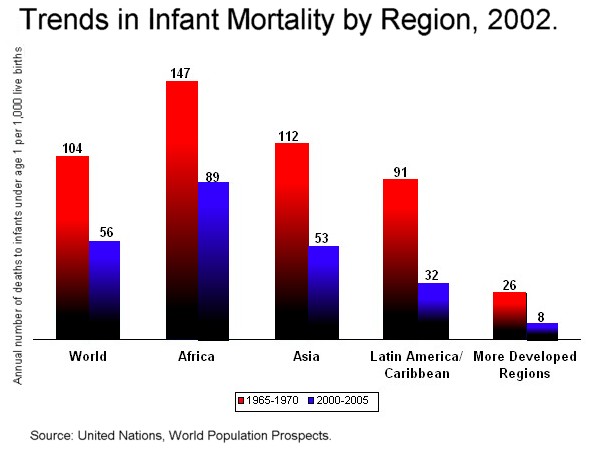
Houses of urban poor built along Basac river bank in Phnom Penh, Tim Acker, Department of Foreign Affairs and Trade, CC 2.0
Global Inequality in the World
In this article, we shall examine the issue of global inequality in the world, and overall global wealth inequality in international relations and international affairs. Specifically, we will discuss issues of financial inequality amongst the different people throughout the world. We will discuss financial inequality as it relates to income, health, education, access to energy, water, amongst other issues. We will also list references related to the topic global inequality in the world.
Global wealth distribution has not been a topic studied in great detail until recent decades. As Branko Milanovic (2006) explains, the reason is that in order to understand global inequality, there is a need for reliable data for countries, which hasn’t been as prevalent as we have seen in the past few decades (1). And while many have been interested in wealth inequality domestically, with the rise of globalization many are stressing the importance of examining global inequality trends (Milanovic, 2012). There are a couple of reasons for this. As Milanovic (2012) explains, “[a]s the world becomes more integrated the global dimension of inequality is likely to become increasingly relevant. This is for at least two reasons: because of much greater movement of factors of production across borders, and because of greater influence of other people’s (foreigners’) standard of living and way of life on one’s perceived income position and aspirations” (2).
However, as Branko Milanovic (2010) explains in his book The Haves and the Have-Nots: A Brief and Idiosyncratic History of Global Inequality, scholars are concerned with global wealth inequality (or the distribution of wealth in the world) in a few specific ways. Namely, scholars of global wealth imbalances are raising questions about brings about unequal wealth distribution in the world, or what happens to global wealth inequality as the economy increases. Other research questions center around how inequality affects different issues such as governance or the economy. The last set of questions revolves around the ethical issues of global wealth inequality (Milanovic, 2010).
Plus, there are many questions about what are the effects of global inequality, particularly with regards to economic global wealth distribution inequality. Some have argued that economic world inequality “strengthens inequality-perpetuating institutions in three ways:
- Inequality discourages the political participation of poor people, which, in turn, diminishes their access to education, health care, and other services that contribute to economic growth and development.
- Inequality often prevents the building and proper functioning of impartial institutions and observance of the rule of law.
- Inequality enables the wealthy to refuse to compromise politically or economically, which further weakens poor societies in a global society at requires relatively fast responses to economic development” (World Bank, 2003, in Payne, 2013: 182).
Global Wealth Inequality in International Affairs
Seeing that effects of global wealth inequality distribution, two of the more frequently asked questions with regards to global inequality has been ‘how great is global inequality, and in what ways does global inequality exist?’ There are many ways to understand international inequality in the global system.
There are three different types of world inequality that are discussed in the policy and academic literature. There are global inequality levels between countries, world inequality based on population sizes, as well as overall global inequality of people, irrespective of where they come from in terms of country (Milanovic, 2012).
Income Inequality: One of the key issues that scholars, policymakers, and practitioners analyze with regards to questions of global poverty and inequality is the level of income levels throughout the world. In a recent 2011 study by Isabel Ortiz and Matthew Cummins that looks at world inequality as it relates to income, they found that “[a]s of 2007, the wealthiest 20 percent of mankind enjoyed nearly 83 percent of total global income compared to the poorest 20 percent, which had exactly a single percentage point under the global accounting model. Perhaps more shocking, the poorest 40 percent of the global population increased its share of total income by less than one percent between 1990 and 2007” (11). And if one measures global income by purchasing power parity, the wealthiest 20 percent control roughly 70 percent of overall income (Ortiz & Cummins, 2011). Income differences are a key factor when looking at global wealth and poverty.

The map shows the Gini Index of income worldwide, according to latest published data by World Bank in July 2014.
Data Source: Table 2.9 of World Development Indicators: Distribution of income or consumption The World Bank (2014)
Gini index is a measure of income inequality, M Tracy Hunter, CC 3.0
Global Inequality as it relates to Children: One of the largest groups affected by global inequality are the children. Children often suffer greatly from minimal access to high income, to education, to access to quality healthcare. Regarding income for example, “…out of the three billion persons under the age of 24 in the world as of 2007, approximately 1.5 billion were living in situations in which they and their families had access to just nine percent of global income. Such findings are not shocking given that poorer families tend to have higher fertility rates. Moving up the distribution pyramid, children and youth do not fare much better: more than two-thirds of the world’s youth have access to less than 20 percent of global wealth, with 86 percent of all young people living on about one-third of world income” (Ortiz & Cummins, 2011: 21). And we see poor conditions for children in both economically poorer states, as well as economically richer states. For example, “The United States — one of the wealthiest nations on Earth — has the second highest rate of childhood poverty in the rich world, according to UNICEF” (in Sutter, 2014). There is a large global economic disparity when it comes to children and overall equality.
Education: Education is a fundamental human right. Yet, there are high disparities between the access to education, as well as resources for education throughout the world. (For statistics as it relates to education inequalities, see UNESCO.
Life Expectancy: Life expectancy is an important measure as it tells us how long the average person in a country will live. This helps us better understand the conditions of a country. In terms of definition, “Life expectancy is an estimate based on projections of death rates…it allows us to compare numbers that make sense at the individual level: How long one can expect to live” (Serneau, 2012: 263-264). When looking at life expectancy rates throughout the world, there is a significant difference in rates between more economically developed states as compared to economically developing states. Below is a chart showing some life expectancy trends.
Infant Mortality: Infant mortality is a major problem in international relations. Infant mortality is “the proportion of children who die before reaching their first birthday” (Serneau, 2012: 264). When looking at infant mortality rates, while there has been a great improvement in reducing rates, there is still many infant deaths, and a division continues to exist between countries in the Global South compared to the Global North (Serneau, 2012).
All of these issues lead to poverty. In fact, Payne (2013) explains that “there are at least six dimensions of poverty:
- Hunger. Poverty throughout the world is about inadequate food supplies.
- Psychological Dimensions. Poverty is usually characterized by a sense of powerlessness, dependency, humiliation, and shame.
- Inadequate Infrastructure. Poor people generally lack access to roads, electricity, clear water, and transportation.
- Low Levels of Literacy. Educational opportunities are often unavailable.
- Health Problems. Poor people everywhere generally suffer from illness, which further impoverishes them.
- Inadequate Income. Poor people stress managing physical, human, social, and environmental assets to cope with their vulnerability. Incomes receive less emphasis (Payne, 2013 198).
What Causes Global Inequality?
There are a number of factors said to lead to global inequality (and also global wealth inequality) between higher economic states and lower economic states. Payne (2013) lists a number of factors, which include the following:
- Geography: Geography is a key factor in understanding global inequality. It has been argued by some that “[c]ountries that are poor…have certain geographic characteristics that contribute to their economic problems. For example, they are in tropic regions or face high transportation costs in accessing global markets because of their location” (in Payne, 2013: 189). Furthermore, a country that is landlocked may have additional difficulties compared to countries with access to ports or are on the water, since “[c]ountries with extensive coastlines and good harbors tend to be better off economically than landlocked countries that lack the physical infrastructure (i.e., a system of roads and railroads) essential for gaining access to navigable rivers and the sea. Landlocked countries or countries located far from the global market are disadvantaged by high transportation costs” (Payne, 2013: 189).
- Colonialism: Colonialism has been a critical factor in understanding global inequality today. Various European powers, for example, carried out repressive actions throughout Africa, South America, Asia, and other parts of the world. In their colonization of these areas, the colonizers altered the politics greatly, often interfering in the government, selecting leaders to back (even though these leaders may have not had citizen interests as a top priority), and divided territory in ways that still can be seen today. But not only did they destabilize the political structures and institutions, but also altered economic conditions in the country. Many of these colonizers continued to manipulate politics and economics in a way that ensured that they would benefit economically. They would often control the resources, and either provide most of the benefits to their communities in these states, or send the resources back to their home state. And as Payne (2013) explains, many of those states who were colonizers still have strong economies and more resources. Furthermore, along with this, other forms of influence, such as outside states backing authoritarian leaders who themselves are doing little to help citizens in their countries have further hurt economic development in these countries.
- Nature of the Global Economic System: Many have argued that a fundamental reason for global inequality has to do with the nature of the economic system. Namely, the economic structuralists have argued that the international capitalist system is one that allows economically richer states to dominate economically poorer states. There is a belief by a number of leaders that states, as well as multinational corporations use economically poorer states for their own economic gain (Payne, 2013). This idea is related to “dependency theory, which holds that poor countries’ reliance on exports of primary commodities, many of which were started during colonization for the benefit of Europeans, puts them at a severe economic disadvantage. The prices obtained from their exports decline relative to the prices of manufactured imports from industrialized countries” (Payne, 2013: 190).
- Population Growth: Population growth has also been said to have an impact on global inequality.
- Government Policies: Government policies are also believed to have a part in global inequality. Corruption in governments, for example, can greatly affect inequalities in a state. If there are individuals who have ties to the state, or have political or economic deals, then they may benefit from this relationship, all the while hurting the society. Furthermore, government policies may focus little on citizen concerns with inequality, particularly if they are not a powerful interest group, or if there exists no voting institutions that hold these leaders accountable for their actions. In addition, states that focus little on efficient development policies, such as education, are going to have inequalities (Payne, 2013).
- Political Unrest: Political unrest can have impact development and can be a cause of global inequality. A country may have resources, or may have capital and infrastructure in place, but if there is domestic unrest, this could hurt economic development (Payne, 2013), and could also have an effect on citizen health, education, etc…
- Natural Disasters: A country that experiences a natural disaster (such as an earthquake, tsunami, hurricane, etc…) can have a difficult time with providing necessary materials for citizens. In this cases, “…natural disasters routinely destroy important economic sectors, increase severe infrastructure problems, force the relocation of a large number of people, and lead to greater impoverishment” (Payne, 2013: 191).
Economic Inequalities Within Countries
While much of the discussion regarding inequality centers around global inequality, and more specifically, comparisons between different countries, it is also important to examine inequality within a country. As we see, there are also vast differences of inequality within states. One example of this is the United States of America. For example, it has been stated that “The United States has the greatest degree of income inequality among industrialized countries. The richest country on earth also has pockets of poverty that are similar to many parts of the developing world. In 2010, 15.1 percent of Americans–46.2 million people–lived below the poverty line, which was defined as an annual income below $22,314 for a family of four” (Payne, 2013: 191). In addition, the issues of inequality are also evident in the US when looking at income and wealth discrepancies. For example, “The poorest 10 percent of Americans receive 1.8 percent of the total income, whereas the richest 10 percent get almost a third” (Payne, 2013: 191).

Income Inequality, The data come from this table: http://www.econ.berkeley.edu/~saez/TabFig2008.xls on Emmanuel Saez’s website at University of California, Berkeley, Emmanuel Saez, CC 3.0
And when looking at other countries, we find similar patterns. For example, many have illustrated the rising economic development in countries such as Brazil, India, China, and Russia (or the BRIC countries). However, once one examines who benefits from this growth, it becomes evident that the returns are not benefiting all equally. It is said that “most of the income from this productivity is concentrated in the top 20-25 percent of the population; the remaining 75-80 percent still are predominantly a peasant society, engaged as they’ve always been in labor-intensive agriculture” (Viotti & Kauppi, 2013: 421). Moreover, when looking at two of the quickest rising economic states, namely China and India, we find a stark difference between those in the top-20 percent of income, and the rest of their respective societies, with “the bottom 20 percent or more still living in varying degrees of poverty” (Viotti & Kauppi, 2013: 421).
How to Fix World Inequality
There have been a number of prescriptions in order to help end world inequality. For example, one of the most important policies that a government should undertake is establishment of education (Payne, 2013). Education has been found to be a critical component for economic development, and for the reduction of global inequality. Education improves life expectancy, decrease infancy mortality and child mortality rates, provides job opportunities, improves income levels, etc… And many have found that this is especially the case for women (Payne, 2013). In fact, when women have education, along with other opportunities to be active in society, this strongly helps overall development (Payne, 2013).
In addition, in order to end world inequality, there also needs to be an emphasis on reducing corruption in society (Payne, 2013). As mentioned above, high levels of corruption often divert resources from where they are most needed, which in turn continues to cause global inequality. Therefore, individuals, non-government organizations, officials, etc… must all speak out against corruption, and call for complete government accountability.
Furthermore, it has also been argued that fighting global poverty and inequality requires governments need to provide support for improving the agricultural sectors of their economics. The reason for this is because “[p]overty and inequality are reinforced by the inability of the poor to produce sufficient food. The poorest countries routinely suffer from food shortage and malnutrition” (Payne, 2013: 200). And yet, these individuals have very little control of land compared to a few, who have much more access and control. Thus, governments must find ways to help individuals in being able to not only have land, but to help provide resources that will aid them in their crop growth (Payne, 2013).
Other arguments for fighting global inequality have been local activism. Volunteering can be a way in which local inequalities can help be stopped. Furthermore, there have also been ways to help provide funds or loans to individuals, either through aid or through microcredit, which can help a person begin a business, which can lead to higher income levels, and move away from poverty (Payne, 2013).
Global Inequality Books
Branko Milanovic, World’s Apart: Measuring International and Global Inequality
Branko Milanovic, The Haves and the Have-Nots: A Brief and Idiosyncratic History of Global Inequality.
References
Milanovic, B. (2006). Global Income Inequality: What Is It and Why It Matters? DESA Working Paper No. 26, August 2006, pages 1-17. Available Online: http://www.un.org/esa/desa/papers/2006/wp26_2006.pdf
Milanovic, B. (2007). World’s Apart: Measuring International and Global Inequality. Princeton, New Jersey. Princeton University Press.
Milanovic, B. (2010). The Haves and The Have-Nots: A Brief and Idiosyncratic History of Global Inequality. New York, New York. Basic Books.
Milanovic, B. (2012). Global Income Inequality By the Numbers: In History and Now. World Bank Policy Research Working Paper. 6259, November 2012, pages 1-28.
Ortiz, I. & Cummins, M. (2011). Global Inequality: Beyond the Bottom Billion. A Rapid Review of Income Distribution in 141 Countries. UNICEF Policy and Practice, April 2011. Available Online: http://www.unicef.org/socialpolicy/files/Global_Inequality.pdf
Payne, R. (2013). Global Issues. New York, New York. Pearson.
Sutter, J.D. (2014). Is Childhood Poverty Inevitable? CNN Opinon. Tuesday November 4th, 2014. Available Online: http://www.cnn.com/2014/11/04/opinion/sutter-child-poverty-launch/index.html?hpt=hp_t4
Viotti, P.R. & Kauppi, M.V. (2013). International Relations and World Politics, Fifth Edition, Upper Saddle River, NJ, Pearson.
World Bank (2003). World Development Report 200, New York, New York. Oxford University Press, page 89.




